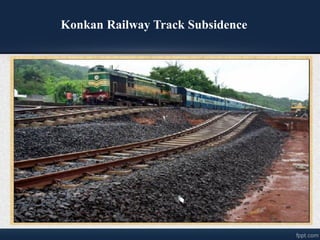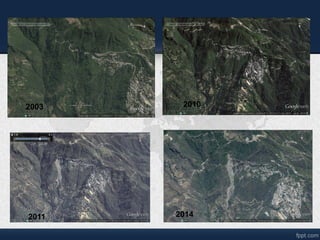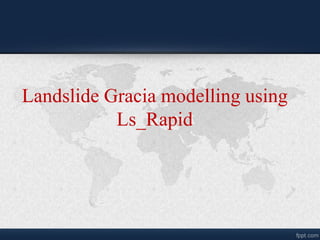14 Summer Training Course
- 1. 14 Summer Training Course for Slope Land Disaster Reduction Olgert Jaupaj, Albania Brajesh Jaiswal, India
- 2. In natural systems, landslides are recognized as one of the most significant Ī░natural hazardsĪ▒ in many areas throughout the world (Crozier and Glade, 2005). Landslide is a general term used to describe the mass movement of soil and rock downslope under gravitational influence. Landslides annually destroy or damage industrial or residential developments, forest and agricultural lands. They are often cause deaths, missing people, injuries and homelessness. They affect settlements, roads and other infrastructures, constituting a major problem worldwide.
- 3. ?In 2006 Philippines (Leyte) rockslides and debris avalanche triggered by heavy rainfall killed 1100 people, 375 homes and a school were destroyed. ?In 2008 China(Sichuan) an earthquake ( 8 magnitude) have been recorded a total of 15.000 landslides, inducing 20.000 deaths ?In 2008 in Egypt (East Cairo) a destabilization due to man-made construction, a rockslide buried part of village destroying 150 houses, 107 deaths and 400 people missing. ?In 2009 Xiolin landslide and debris flow triggered by typhoon Morakot killed more the 400 people ?In 2010 Uganda(Bududa) debris flows triggered by heavy rainfall killed more than 400 people, and 200.000 displaced ?In 2011 Brazil (Nova Friburgo RJ) with more than 1'000 landslides in a radius of 50 km, killed more than 1'000 people, dozens of injured and at least 20'0000 persons homeless and destroyed Examples of large landslides around the world
- 4. Some examples of large landslides that have occurred in Albania in recent years ?In 1977 Moglice (Korce) a huge landslide triggered by heavy rainfall destroyed more than 50 house ? In 2008 Gjirokaster a destabilization due to man-made construction, a landslides killed 3 people, a building were destroyed ?In 2009 Synei (Kavaje) landslides triggered by heavy rainfall , 8 houses ,roads and other infrastructures were destroyed were destroyed but fortunately no death ?In 2013 in Ngarcia (Gjirokaster) triggered by heavy rainfall, 11 houses, roads and other infrastucture were destroid but fortunately no death
- 5. Number of great natural catostrophes & associated economic losses worldwide 1950-2010
- 6. Landslide affected regions of India 1 2 3 1. Western Himalayas (Uttarakhand, Himachal Pradesh and Jammu & Kashmir) 2. Eastern and N.E Himalayas (West Bengal, Sikkim and Arunachal Pradesh) , Naga-Arakkan Mountain belt (Nagaland, Manipur, Mizoram and Tripura) 3. Western Ghats including Nilgiris (Maharashtra, Goa, Karnataka, Kerala & Tamil Nadu)
- 7. Landslide Facts ?Landslides rank third in terms of number of deaths due to natural disasters. ?Landslides kill 1 person / 100 Km?/ yr. ?Estimated average losses due to landslides in Himalaya costs > Rs. 550 crores / yr. & > 200 deaths.
- 8. Konkan Railway Track Subsidence
- 9. Landslide blocks Konkan Railway Track
- 13. B2 Landslide Sikkim (NH-39) 9th Mile Landslide Sikkim (NH-39) Tangni Landslide Uttaranchal (NH-58) Kaliyasaur Landslide Uttaranchal (NH-58) Patalganga Landslide Uttaranchal (NH-58) Narendranagar Landslide Uttaranchal (NH-58)
- 14. Year Place Death 1998 Malpa, Pithoragarh district 210 1998 Okhimath, Rudraprayag district 107 2002 Ghansyali Tehsil, Tehri- Garhwal 29 2004 Chamoli District 25 2014 Malin, Pune 150 Landslide of India
- 16. Introduction
- 17. Study Area ?The study area is a part of Alaknanada Bhagirathi and Ganges basin which lies in the state of Uttarakhand, India extends with area of 1093.44 sq.km ?Lat/Long extend from 30ĪŃ1'53.56"N, 78ĪŃ15'24.27"E to 30ĪŃ35'5.74"N, 79ĪŃ35'43.56"E
- 18. Field Photographs Devprayag area as seen on satellite image. A field view of overloading of hill slope at Devprayag A field view of overloaded slope by multi- stored building at Devprayag.
- 19. Chamoli and surrounding area as viewed from satellite image. A field view of rock fall zone further north of Chamoli. Joint openings of more than 8 cm are visible. A field view of active slide zone in the immediate upslope of Birahi Ganga Bridge.
- 20. A field view of cracks developed in houses due to slow land subsidence in Saikot
- 21. Data and Software Used ©C DATA USED ? ASTER 30m x 30m resolution DEM (Digital Elevation model) ? Lithology Map (1:50000) ? Weathering Map (1:50000) ? Road Map ©C SOFTWARE USED ? The following given below software were used to process, create, manipulate and analyse the data for our study: ? ArcGIS 10 ? ERDAS IMAGINE 9.1 ? Google Earth
- 22. Elevation Map And distribution of Landslides A high elevation has high potential energy and thus is a causative factor for landslide. Th landslides in the study area ranges from 411m to 2843m with mean elevation of 1015.67m. Most of the large to medium landslides were found to be occurred at elevation higher 1000 m. A large number of small landslides were found to be occurred at mean elevation of about 956 m.
- 23. Slope Map And distribution of Landslides Slope is most important causative factor of landslide. Steep slopes are more vulnerable to landslide while gentle slopes are stable. The slope for landslides varied from about 10ĪŃ to upto about 63ĪŃ. Most of the landslides were found to be concentrated on steep slopes. About 59% of landslides were occurred on unstable slopes (30ĪŃ and above).
- 24. Lithology Map and distribution of Landslide Study area has various lithological units having asymmetrical area distributions. First five major lithological units, covers most of the study area. Landslides number varied through these lithological units. Most of these landslides, about 74%, were concentrated on three major lithological units i.e to dark grey phyllite with slate, biotite schist with grey granite gneiss and sandstone with shale.
- 25. Distribution of Landslides on different Lithology and mean slope of Landslides
- 26. Distribution of Landslides among different Weathered zone Weathering in the study area varied from very high weathering to nil weathering and had five categories i.e Very high, High, Moderate, Low and Nil. 58% of the area is low weathered while about 36% of the area is high to moderately weathered. About half of the landslides were present in the low weathered zone. High and moderate weathered zone had about 45% of landslides. Rest were present in very high and Nil weathered zone.
- 27. Landslide relation with weathering
- 28. Proximity of landslides to road A significant correlation between identified landslides and proximity to road was observed. Almost 94% landslides were either on the road side or near the road (within 1km distance). It showed that most of the landslides were due to anthropogenic activity i.e due to road construction. Only 6% of landslides were occurred due to natural processes.
- 29. Spatio-temporal change of Kaliyasur Landslide
- 30. ?Kaliyasaur landslide is located on a sharp bend at a distance of 171 km from Badrinath between Rudraprayag and Srinagar at an altitude of 700 m near Kaliyasaur village. ?This landslide is repeatedly activated many times such as in 1952, 1963, 1965, 1969, 1970, 1971, 1972, 1984, and 1985. ?The rocks exposed on the slide face are the white and pink quartzite inter bedded with slate (Bhandari, 1987).
- 32. ?Increase in instability of slope is due to cutting slopes during road construction and heavy rainfall are major cause of landslides in mountainous areas. ?Three major lithological units found in the study area are fragile. Foliated structure found in these lithologies has tendency to slide and slope cutting or heavy rainfall could easily make slopes instable towards sliding. ?Lineaments such as fracture, joints, faults present in the rock structure, exhibits zone of weakness were present in large number in the study area. Though, there were large numbers of landslides within the vicinity of these lineaments, most of these landslides were along the roads. Discussion
- 33. The study area is found to be highly prone to landslides. Weak lithologies, weak lineament zones, varied degree of physical and chemical weathering and road construction or widening are the major reasons behind the instability or vulnerability of steep slopes towards landslides Conclusion
- 34. FUTURE WORK
- 35. Instrumentation & Monitoring of Landslide Rainguage Control Station Camra Inclinometer Piezometer Wire Extensometers
- 36. Inclinometer Piezometer Extensometer Rainguage Monitoring Camra Remote Control Station REAL TIME DATA
- 37. Landslide Gracia modelling using Ls_Rapid
- 38. Ngarcia Landslide occur in 25, March 2013 in Gracia village triggered by heavy rainfall, 11 houses, roads and other infrastucture were destroid but fortunately no death Geographically, the LANDSLIDE is located in south-western part of Albania GEOGRAPHY OF STUDY AREA
- 42. FOTO KU TE JEM EDHE UNE NGA ATO FOTOT QE KEMI BERE BASHKE
- 43. DATA PREPARATION Create the DEM of the study are from the topografic map using Arc_GIS Create the DEM of landslide are using Arc_GIS Export the DEM in ASCII and modifie for the LS-Rapid Soil parameters Other parameters (e.g., time, output, display)
- 49. ųxųx Ī░

















































